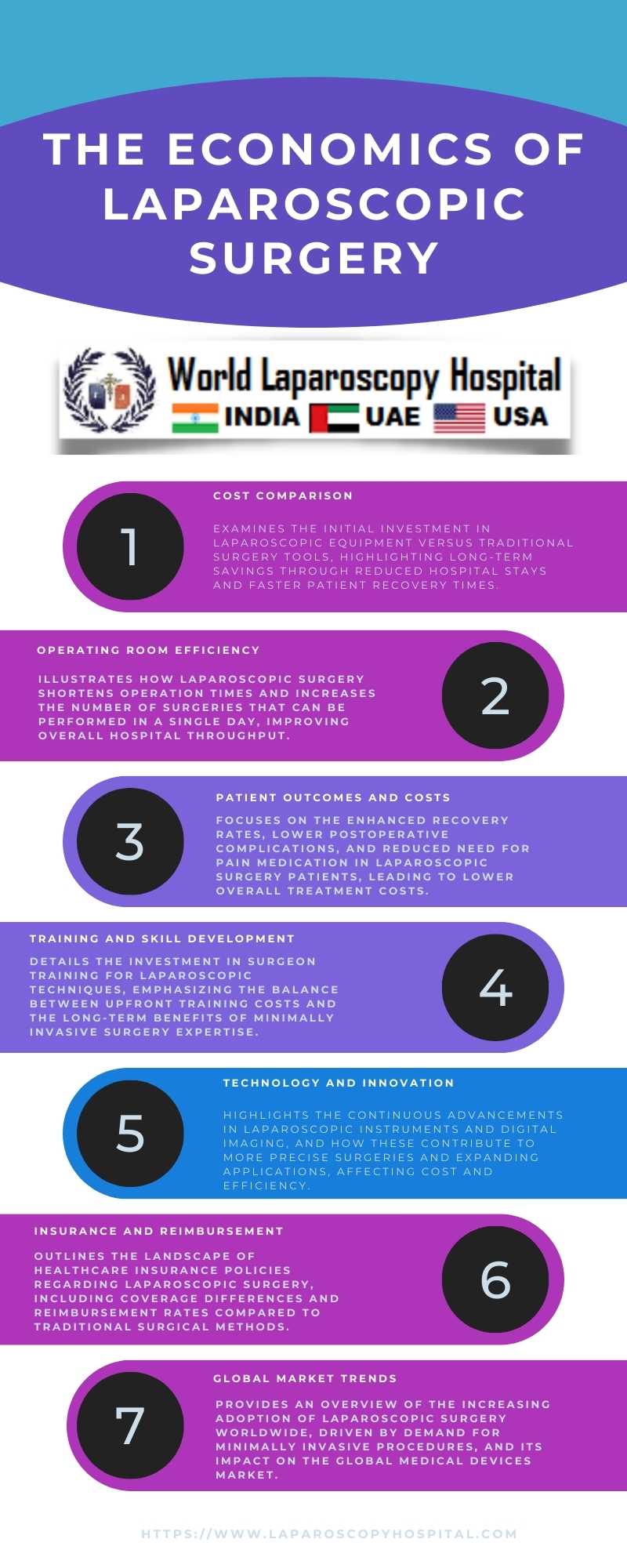The Economics of Laparoscopic Surgery: Cost-Benefit Analysis
The economics of laparoscopic surgery encompass a broad and complex analysis of costs and benefits, both from the perspective of healthcare providers and patients. This essay delves into the various economic aspects of laparoscopic surgery, comparing it with traditional open surgery, and examines the implications of its cost-effectiveness on healthcare systems and patient outcomes.

Laparoscopic surgery, also known as minimally invasive surgery, has revolutionized many fields of medicine by offering an alternative to traditional open surgical procedures. Its key characteristics include small incisions, reduced pain and scarring, shorter hospital stays, and faster recovery times. These advantages not only contribute to improved patient outcomes but also have significant economic implications.
From a cost perspective, laparoscopic surgery can be more expensive initially due to the need for specialized equipment and the training required for surgeons to become proficient in these techniques. The high upfront costs of laparoscopic instruments and maintenance of the equipment can be a barrier for some healthcare facilities, especially in lower-income regions or countries. However, when considering the entire treatment cycle, the overall costs associated with laparoscopic procedures may be lower than those for open surgeries. The reduced hospital stay and faster return to work contribute to significant savings for both healthcare systems and patients.
The benefit analysis of laparoscopic surgery extends beyond financial considerations. The less invasive nature of the procedure leads to fewer complications, such as infections or postoperative hernias, which in turn reduces the need for additional treatments or interventions. This not only enhances the quality of life for patients but also decreases long-term healthcare expenses.
Furthermore, the economic analysis of laparoscopic surgery must consider the broader societal impacts. The quicker recovery times allow patients to return to their normal activities and work more rapidly, reducing the indirect costs associated with lost productivity. This aspect is particularly significant in economies where the workforce plays a crucial role in economic stability and growth.
However, the economic benefits of laparoscopic surgery are not uniformly distributed across all types of procedures and patient populations. The cost-benefit ratio can vary significantly depending on the specific surgery, the patient's condition, and the healthcare setting. Therefore, a detailed analysis is necessary for each case to determine the most cost-effective approach.
Conclusion
The economics of laparoscopic surgery present a complex picture that encompasses initial higher costs but offers significant benefits in terms of reduced postoperative care, faster recovery, and lower long-term healthcare costs. The adoption of laparoscopic techniques can lead to substantial economic savings for healthcare systems and societal benefits through improved patient outcomes and increased productivity. However, careful consideration of the specific circumstances and patient needs is essential to maximize the economic advantages of this innovative surgical approach.

Laparoscopic surgery, also known as minimally invasive surgery, has revolutionized many fields of medicine by offering an alternative to traditional open surgical procedures. Its key characteristics include small incisions, reduced pain and scarring, shorter hospital stays, and faster recovery times. These advantages not only contribute to improved patient outcomes but also have significant economic implications.
From a cost perspective, laparoscopic surgery can be more expensive initially due to the need for specialized equipment and the training required for surgeons to become proficient in these techniques. The high upfront costs of laparoscopic instruments and maintenance of the equipment can be a barrier for some healthcare facilities, especially in lower-income regions or countries. However, when considering the entire treatment cycle, the overall costs associated with laparoscopic procedures may be lower than those for open surgeries. The reduced hospital stay and faster return to work contribute to significant savings for both healthcare systems and patients.
The benefit analysis of laparoscopic surgery extends beyond financial considerations. The less invasive nature of the procedure leads to fewer complications, such as infections or postoperative hernias, which in turn reduces the need for additional treatments or interventions. This not only enhances the quality of life for patients but also decreases long-term healthcare expenses.
Furthermore, the economic analysis of laparoscopic surgery must consider the broader societal impacts. The quicker recovery times allow patients to return to their normal activities and work more rapidly, reducing the indirect costs associated with lost productivity. This aspect is particularly significant in economies where the workforce plays a crucial role in economic stability and growth.
However, the economic benefits of laparoscopic surgery are not uniformly distributed across all types of procedures and patient populations. The cost-benefit ratio can vary significantly depending on the specific surgery, the patient's condition, and the healthcare setting. Therefore, a detailed analysis is necessary for each case to determine the most cost-effective approach.
Conclusion
The economics of laparoscopic surgery present a complex picture that encompasses initial higher costs but offers significant benefits in terms of reduced postoperative care, faster recovery, and lower long-term healthcare costs. The adoption of laparoscopic techniques can lead to substantial economic savings for healthcare systems and societal benefits through improved patient outcomes and increased productivity. However, careful consideration of the specific circumstances and patient needs is essential to maximize the economic advantages of this innovative surgical approach.
1 COMMENTS
Dr. Abhimanyu Singh
#1
Feb 16th, 2024 6:47 am
Laparoscopic surgery's economic landscape is intricate: initial expenses, offset by post-op savings, speedier recovery, and lower healthcare costs. Widespread adoption promises substantial savings and societal gains, but tailored strategies are vital for optimal outcomes.
| Older Post | Home | Newer Post |

